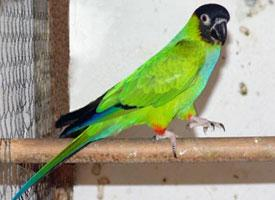
Známé také jako
- Aratinga černohlavý
- Papoušek černohlavý
Váhy a míry
| Délka | od 28 do 37 cm |
|---|---|
| Hmotnost | od 130 do 150 g |
Popis zvířete
The Nanday Parakeet, scientifically known as Nandayus nenday, is a captivating species of parrot native to South America, specifically found in the woodlands and savannas of Brazil, Bolivia, Paraguay, and Argentina. This species is notable for its striking appearance, sociable nature, and adaptability, which have also made it a popular pet around the world. As a result of the pet trade and escaped birds, the Nanday Parakeet has established feral populations in several parts of the United States, including Florida, California, and Texas, demonstrating its remarkable ability to adapt to new environments.Adult Nanday Parakeets are medium-sized birds, typically measuring about 32 to 37 cm in length, including their long, tapering tails. They weigh approximately 140 grams. One of the most distinctive features of this species is its coloration. The bird's body is primarily a bright green, which beautifully contrasts with its striking black head. The feathers on the back of the neck and upper back are a bluish-black, blending seamlessly into the green of the body. Another distinctive feature is the reddish-orange feathers around the legs and lower abdomen, adding a splash of color to their otherwise green and black plumage. Their wings exhibit a dazzling blue on the flight feathers, which becomes visible when the bird is in flight. The beak is black, robust, and designed for cracking open nuts and seeds, which constitute a significant part of their diet.
Nanday Parakeets have a loud and distinct call, which is often described as a raucous chatter. This vocalization plays a crucial role in social interactions within flocks and also serves as an alarm signal when they perceive threats. They are highly social animals, often seen in flocks of varying sizes, and this gregarious nature extends to their interactions with humans, making them engaging pets.
In the wild, the Nanday Parakeet's diet is diverse, consisting mainly of seeds, fruits, berries, and occasionally insects and their larvae. Their strong beak allows them to exploit a range of food sources, contributing to their adaptability to different environments.
Breeding season for the Nanday Parakeet varies depending on their location but typically occurs during the warmer months, when food is abundant. They are cavity nesters, preferring to nest in tree hollows or even utilizing abandoned nests of other birds. The female lays between 3 to 4 eggs, which are incubated for about 24 days. Both parents are involved in rearing the young, which fledge approximately 8 weeks after hatching.
Despite their popularity and adaptability, Nanday Parakeets face threats from habitat destruction and the pet trade. In their native range, deforestation and changes in land use have led to habitat loss. Meanwhile, trapping for the pet trade has also impacted wild populations, although to a lesser extent due to breeding programs that have reduced the demand for wild-caught birds.
The Nanday Parakeet is a species that embodies resilience and adaptability, thriving in both its natural habitat and urban environments. Its striking appearance, social nature, and intelligence have endeared it to bird enthusiasts around the world, highlighting the importance of conserving this remarkable species and its habitat.
Podobná zvířata
Nové fotografie zvířat
Top 10 zvířat
- Dolphin gull (Leucophaeus scoresbii)
- Stone loach (Barbatula barbatula)
- Diana monkey (Cercopithecus diana)
- Japanese macaque (Macaca fuscata)
- Greek tortoise (Testudo graeca)
- Galápagos tortoise (Geochelone nigra complex)
- Moustached guenon (Cercopithecus cephus)
- Russian tortoise (Testudo horsfieldii)
- Galápagos penguin (Spheniscus mendiculus)
- Common flying dragon (Draco volans)


